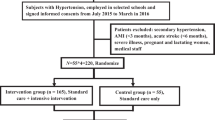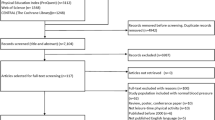Abstract
Lifestyle factors like weight, alcohol consumption, salt intake and physical activity have shown to be important in treating hypertension. There have been made some randomised trials about the effects of lifestyle interventions, but the numbers of patients have been relatively small and the durations of follow-ups have been short. No controlled trials assessing the effects of lifestyle intervention in a rehabilitation setting have been reported. In this study, the effects of multidisciplinary lifestyle intervention in rehabilitation centres among middle-aged hypertensive employees were described. A total of 731 hypertensives from 45 worksites were randomised to lifestyle intervention in a rehabilitation centre or to usual care in an occupational or primary health-care centre for 12 months. Standard measurements were conducted before the intervention and 1-year later. Blood pressure (BP) levels were clearly reduced in the intervention group, while only minor changes were observed in the control group. The net changes between the two groups both for systolic and diastolic BPs were −2.1 mmHg (95% confidence intervals (CI) −4.0 to −0.1) and −1.5 mmHg (95% CI −2.6 to −0.4), respectively. The net changes were greater among men than women. The multidisciplinary lifestyle intervention in a rehabilitation centre setting produced significant reductions in BP among middle-aged employees with hypertension.
This is a preview of subscription content, access via your institution
Access options
Subscribe to this journal
Receive 12 digital issues and online access to articles
$119.00 per year
only $9.92 per issue
Buy this article
- Purchase on Springer Link
- Instant access to full article PDF
Prices may be subject to local taxes which are calculated during checkout

Similar content being viewed by others
References
MacMahon S et al. Blood pressure, stroke and coronary heart disease. Part 1, Prolonged differences in blood pressure: prospective observational studies corrected for the regression dilution bias. Lancet 1990; 335: 765–774.
Stamler J, Neaton JD, Wentworth DN . Blood pressure (systolic and diastolic) and risk of fatal coronary heart disease. Hypertension 1989; 13 (Suppl I): 2–12.
Reid DD, Hamilton PJS, McCartney P, Rose G . Smoking and other risk factors for coronary heart disease in British civil servants. Lancet 1976; ii: 979–984.
Staessen J, Wang J-G, Thijs L . Cardiovascular protection and blood pressure reduction: a meta-analysis. Lancet 2001; 358: 1305–1315.
INTERSALT Cooperative Research Group. INTERS ALT: an international study of electrolyte excretion and blood pressure: results for 24-hour urinary sodium and potassium excretion. BMJ 1988; 297: 319–328.
Stamler R et al. Nutritional therapy for high blood pressure: final report of a four-year randomized controlled trial—The Hypertension Control Program. JAMA 1987; 257: 1484–1491.
Stamler R et al. Primary prevention of hypertension by nutritional-hygienic means. JAMA 1989; 262: 1801–1807.
Halbert JA et al. The effectiveness of exercise training in lowering blood pressure: a meta-analysis of randomised controlled trials of 4 weeks or longer. J Hum Hypertens 1997; 11: 641–649.
Cooper AR, Moore LA, McKenna J, Riddoch CJ . What is the magnitude of blood pressure response to a programme of moderate intensity exercise? Randomised controlled trial among sedentary adults with unmedicated hypertension. Br J Gen Pract 2000; 50: 958–962.
Cutler JA, Follmann D, Elliott P, Suh I . An overview of randomized trials of sodium reduction and blood pressure. Hypertension 1991; 17 (Suppl I): I-27–I-33.
Sacks F et al. Effects on blood pressure of reduced dietary sodium and the dietary approaches to stop hypertension (DASH) diet. N Engl J Med 2001; 344: 3–10.
Langford HG et al., for the TAIM Research Group. Effect of drug and diet treatment of mild hypertension on diastolic blood pressure. Hypertension. 1991; 17: 210–217.
Grimm RH et al., for The Treatment of Mild Hypertension Study (TOMHS) Research Group. Long-term effects on plasma lipids of diet and drugs to treat hypertension. JAMA 1996; 275: 1549–1556.
Puska P et al. Controlled, randomized trial of the effect of dietary fat on blood pressure. Lancet 1983; 1: 1–5.
Joint National Committee. The sixth report of the Joint National Committee on detection, evaluation and treatment of high blood pressure (JNC VI). National Institute of Health Publication 1997 No. 98-4080.
WHO-ISH 1999 World Health Organization—International Society of Hypertension. Guidelines for the management of hypertension. Guidelines Subcommittee. J Hypertens 1999; 17: 151–183.
British Hypertension Society guidelines for hypertension management 1999: summary. BMJ 1999; 319: 630–635.
Marquez-Vidal P, Tuomilehto J . Hypertension treatment and control in the community: is the rule of halves still valid? J Hum Hypertens 1997; 11: 213–220.
Elmer PJ et al., for the TOMHS Research Group. Lifestyle intervention: results of the treatment of mild hypertension study (TOMHS). Prev Med 1995; 24: 378–388.
The Trials of Hypertension Prevention Collaborative Research Group. The effects of nonpharmacologic interventions on blood pressure of persons with high normal levels: results of the trials of hypertension prevention, phase I. JAMA 1992; 267: 1213–1220.
Altman DG . Practical Statistics for Medical Research, Ist ed. Chapman & Hall: London, 1991, pp. 455–458.
Hense HW et al. Quality assessment of blood pressure measurements in epidemiological surveys. The impact of last digit preference and the proportions of identical duplicate measurements. WHO Monica Project. Rev Epidem Sante Publ 1990; 38: 463–468.
Vartiainen E et al. Cardiovascular risk factor changes in Finland, 1972–1997. Int J Epidemiol 2000; 29: 49–56.
Oja P et al. A 2-km walking test for assessing the cardiorespiratory fitness of healthy adults. Int J Sports Med 1991; 12: 356–362.
Vickers A, Altman D . Analysing controlled trials with baseline and follow up measurements. BMJ 2001; 323: 1123–1124.
Nelder JA, Wedderburn RWM . Generalized linear models. J R Statist Soc A 1972; 135: 370–384.
McCullagh P, Nelder JA . Generalized Linear Models. 2nd ed. Chapman & Hall: London, 1989.
Diggle PJ, Liang KY, Zeger SL . Analysis of Longitudinal Data. Clarendon Press: Oxford, 1994.
Rosolova H, Chrastek J, Zikmund M, Simon J . Non-pharmacological control of blood pressure and physical fitness in subjects with arterial hypertension. Cor Vasa 1991; 33: 123–131.
Sjöstrom M et al. A four week residential program for primary health care patients to control obesity and related heart risk factors: effective application of principles of learning and lifestyle change. Em J Clin Nutr 1999; 53 (Suppl 2): S72–S77.
Ebrahim S, Smith GD . Systematic review of randomised controlled trials of multiple risk factor interventions for preventing coronary heart disease. BMJ 1997; 314: 1666–1674.
Acknowledgements
We thank the staff of the three rehabilitation centres (Rehabilitation Centre Imatra, Rehabilitation Centre Korpilampi and Rehabilitation Centre Savonlinna) and the occupational health-care units and patients of the worksites for their help with conducting this study. We also thank Pertti Mutanen and Seppo Sarna for their statistical help. RAY (Finland's Slot Machine Association) gave an economic support to this study.
Author information
Authors and Affiliations
Corresponding author
Rights and permissions
About this article
Cite this article
Mattila, R., Malmivaara, A., Kastarinen, M. et al. Effectiveness of multidisciplinary lifestyle intervention for hypertension: a randomised controlled trial. J Hum Hypertens 17, 199–205 (2003). https://doi.org/10.1038/sj.jhh.1001531
Received:
Revised:
Accepted:
Published:
Issue Date:
DOI: https://doi.org/10.1038/sj.jhh.1001531
Keywords
This article is cited by
-
Effect of leisure-time physical activity on blood pressure in people with hypertension: a systematic review and meta-analysis
Scientific Reports (2023)
-
Reduction of cardiovascular risk factors among young men with hypertension using an interactive decision aid: cluster-randomized control trial
BMC Cardiovascular Disorders (2021)
-
Evaluation of the quality of care of a multi-disciplinary Risk Factor Assessment and Management Programme for Hypertension (RAMP-HT)
BMC Family Practice (2015)
-
Documented Lifestyle Education Among Young Adults with Incident Hypertension
Journal of General Internal Medicine (2015)
-
Prevalence, awareness, treatment and control of hypertension in elderly Chinese
Hypertension Research (2013)



